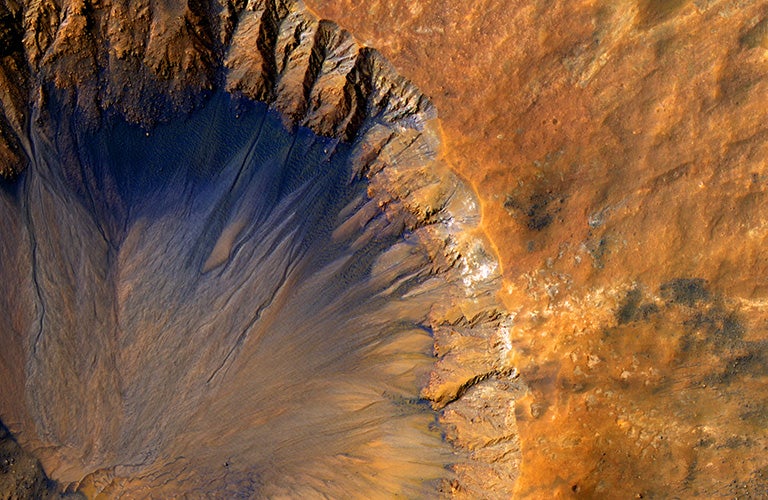Johnson Leads Major Grant to Redefine Extraterrestrial Life Detection
November 1, 2018 — How should we look for life outside of Earth if we know that it might not possess any characteristics of Earth life? It’s a fundamental question at the center of the ambitions humans have for space exploration — and one a new research team will tackle head-on.
NASA’s Astrobiology Program has awarded a nearly $7 million grant to an effort led by Georgetown Assistant Professor Sarah Stewart Johnson that is explicitly aimed at throwing out the assumption that life out in space will be like life here at home.
Over the next five years, the interdisciplinary project, called the Laboratory for Agnostic Biosignatures, will develop a new class of life detection approaches for use on planetary missions – from the subsurface of the Red Planet to the farthest reaches of our solar system.
LIFE AS WE DON’T KNOW IT
“Time and again, we’ve been bowled over by the indescribable foreignness of other worlds,” said Johnson, the project’s principal investigator. Yet the search for extraterrestrial life often defaults to assumptions that arise from experiences with life detection on Earth.
“Detecting life in an agnostic fashion,” said deputy principal investigator Heather Graham of NASA Goddard Space Flight Center, “means not using characteristics particular to Earth life.”
For example, the team will consider states of disequilibrium with the surrounding environment, such as evidence of conspicuous chemical complexity or unexpected accumulations of chemical elements. They’ll also look for patterns of energy transfer in the hope that such aberrations could tip off the researchers to the existence of life.
The key for the project is to identify indicators that are not biased toward the specific type of biochemistry found on Earth. The life detection methods must also be suitable for eventual implementation on flight missions.
“Our goal is to go beyond what we currently understand and devise ways to find forms of life we can scarcely imagine,” Johnson said.
A SPECTRUM OF CERTAINTY
In another break from many existing efforts, the project will also explore ways to think about the discovery of life in terms of probabilities and thresholds, as opposed to seeking a simple “yes” or “no” as to whether life has been discovered.
“When you’re looking for extraterrestrial life, results may be messier than just ‘yes we found life’ or ‘no we didn’t,’” Johnson said. “To do that, we’ll need to think less about whether life fits our preconceptions of what life is, and more about how to quantify the difference between what we see and what we might expect from an abiotic environment.”
The project will therefore support computational efforts to develop probabilistic and theoretical models, some of which will depend on advanced algorithmic and machine learning techniques. It will also oversee the analysis of a wide array of organic and inorganic substrates, including abiotic extracts from meteorites, which will be used to develop and refine these tools and algorithms.
CONNECTING THE COMMUNITY
The project unites a diverse team of planetary scientists, biologists, chemists, computer scientists, mathematicians, and veteran instrument scientists from the United States and around the world.
In addition to Professor Johnson and Dr. Graham, the team includes Eric Anslyn (University of Texas at Austin), Pan Conrad (Carnegie Institute), Lee Cronin (University of Glasgow), Andrew Ellington (University of Texas at Austin), Jamie Elsila (NASA Goddard), Pete Girguis (Harvard University), Chris House (Pennsylvania State University), Chris Kempes (Santa Fe Institute), Eric Libby (Santa Fe Institute), Paul Mahaffy (NASA Goddard), Jay Nadeau (Portland State University), Barbara Sherwood Lollar (University of Toronto), and Andrew Steele (Carnegie Institute).
The Laboratory for Agnostic Biosignatures project is part of the NASA Astrobiology Program’s new Network for Life Detection (NfoLD), also announced this week. NfoLD is a multi-institution initiative focused on catalyzing and connecting the broader life detection research community. The Laboratory for Agnostic Biosignatures will form one of NfoLD’s core teams, along with teams led by the Georgia Institute of Technology and NASA Ames Research Center. Professor Johnson will serve as one of the new initiative’s co-leads.
You can follow the latest developments of the Laboratory for Agnostic Biosignatures project, including publications and upcoming events, on their website. More information on NfoLD and NASA’s Astrobiology Program can be found here.
— Patrick Curran
